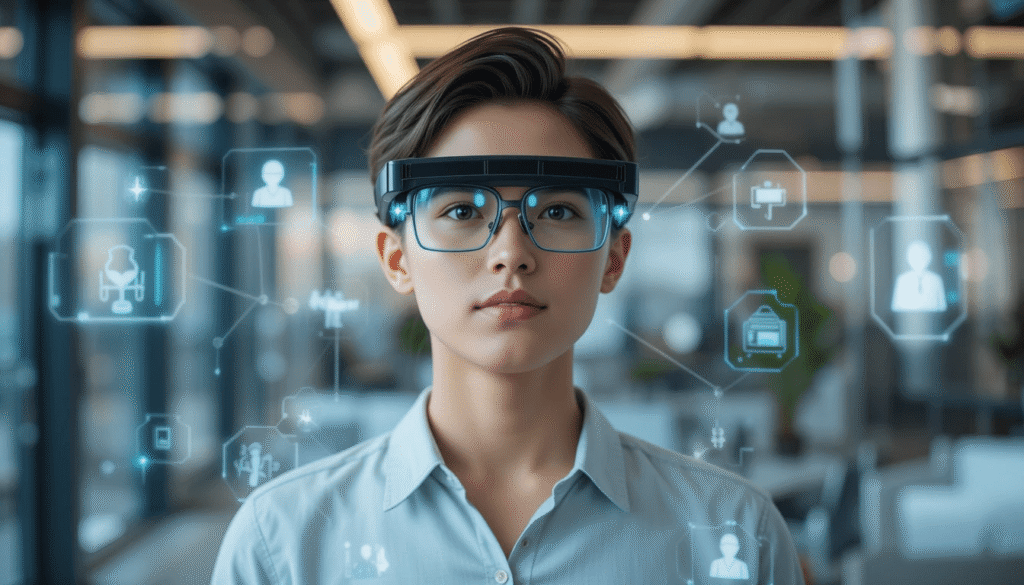In 2025, Augmented Reality (AR) isn’t just a tech buzzword — it’s becoming part of how we live, work, learn, and heal. Whether you’re picking out a sofa in Delhi, exploring planets in a Bangalore classroom, or guiding surgery in Mumbai with real-time overlays — AR is weaving itself into the fabric of daily life.
But beneath the cool features and flashy demos, a deeper question emerges: Where is AR really headed? And more importantly, what could it mean for India — a country full of complexity, creativity, and contrast?
What is Augmented Reality?
Augmented Reality (AR) brings digital content into your physical world — not by replacing it, but by enhancing it. Think of a cartoon character dancing on your desk or a street sign that instantly translates before your eyes. Unlike Virtual Reality (VR), which pulls you into a fully digital environment, AR adds an extra layer of meaning to what’s already around you.
You’ve probably experienced it already:
- For example, Snapchat filters that add fun effects to your face
- Or Pokémon GO placing animated creatures in your neighborhood
- Even Google Maps Live View guiding you with arrows on real streets
Clearly, AR isn’t just for games anymore. It’s helping teachers engage students, doctors perform better surgeries, and brands connect with customers in meaningful ways.
The Booming AR Market

The AR landscape is growing at a breathtaking pace:
- Grand View Research forecasts the global AR market will hit $599.6 billion by 2030, expanding at 37.9% CAGR (2025–30).
- Meanwhile, Markets & Markets—which tracks combined AR + VR revenue—estimates the sector was $10.9 billion in 2024, rising to $60.3 billion by 2029 at a 40.7% CAGR.
These figures may vary depending on how AR is defined — whether it includes hardware, software, or both — but the trend is clear: AR is booming.
In India, AR is building real momentum in:
- Education, where interactive AR/VR tools help students grasp concepts visually — part of a sector growing at ~38% CAGR, with AR/VR spending reaching US$14 bn by 2027.
- Retail, where platforms like Flipkart, Myntra, and Lenskart now offer virtual try-ons and 3D previews — making it easier for shoppers to buy with confidence.
- Healthcare, where hospitals are using AR/XR for surgical visualization, training, patient education, and remote care — especially in the southern states where the ecosystem is strongest.
- Skilling & Job Training, with vocational simulations and enterprise training programs delivered via AR platforms — helping users gain safety, retention, and hands-on experience.
How AR is Changing Everyday Work
Retail & E-commerce 🛍️
- IKEA Kreativ helps customers visualize furniture at home.
- L’Oréal’s ModiFace offers virtual makeup try-ons — now integrated into Indian beauty apps.
- Flipkart Camera lets shoppers explore products in 3D.
- As a result, some brands report up to 71% higher conversion rates.
Healthcare & Surgery 🧬
- Indian surgeons now use AR to view organs while operating.
- A UK-based app, Strolll, is aiding Parkinson’s patients in Indian clinics.
- In some medical colleges, AR tools are replacing cadavers in anatomy classes.
Manufacturing & Maintenance 🧰
- AR delivers real-time instructions directly onto machinery.
- This hands-free guidance helps Indian workers perform tasks more quickly and safely.
Education & Training 📚
- AR is turning textbooks into living experiences.
- Government initiatives are pushing AR into classrooms across rural India.
- Startups are using it to teach trades — from plumbing to nursing — with step-by-step simulations.
Challenges Augmented Reality Must Navigate Globally
Of course, no innovation is perfect. AR faces its share of challenges worldwide:
- Cost: Most advanced AR headsets remain expensive, limiting access. That’s why mobile-based solutions are gaining more traction.
- Privacy: Since AR collects real-time personal data, stronger privacy laws and ethical frameworks are urgently needed.
- Tech Gaps: Budget smartphones still struggle to handle high-performance AR applications effectively.
- Digital Divide: Many rural and low-income communities lack consistent internet and modern devices to fully access AR experiences.
- Lack of Clear Rules: There’s still a major gap in global policy and regulation around AR, from user consent to content moderation.
For AR to succeed, innovation must move hand-in-hand with inclusion, safety, and strong digital rights.
What’s Next: Smart Glasses & Blended Realities 👓
The next leap? AR you wear.
- Meta x Ray-Ban Glasses are already gaining popularity in India’s content creator circles.
- Apple Vision Pro isn’t here yet — but Indian developers are building apps in anticipation.
- Xreal Air is emerging as a favorite among young gamers.
- Behind the scenes, firms like Infosys and TCS are building custom AR tools for global clients.
Very soon, checking WhatsApp through your glasses or seeing step-by-step recipes float beside your stove won’t be a dream — it’ll be everyday reality.
Frequently Asked Questions (FAQ)
Q1: How is AR being used in Indian education?
AR is making learning more immersive in schools across India. With the help of AR apps, students can now visualize complex subjects like science and mathematics in 3D. This approach especially benefits schools in underserved or rural areas, where traditional resources may be limited.
Q2: What are the biggest AR companies in India in 2025?
Leading the way are companies like AjnaLens (focused on defense and healthcare), Whodat Tech (real estate visualization), and Scapic (e-commerce and virtual product experiences). These firms are driving innovation and building practical AR solutions for real-world problems.
Q3: Is India ready for wearable AR like smart glasses?
Yes, particularly in urban areas. While mobile AR remains dominant, interest in smart glasses is rising — especially among content creators, field professionals, and tech enthusiasts in cities like Mumbai, Delhi, and Bangalore.
Q4: Which sectors will AR impact the most in India?
AR is set to transform several major sectors, including education, healthcare, retail, manufacturing, logistics, and job training. Each of these industries is already exploring AR-powered tools to improve engagement, efficiency, and outcomes.
Q5: Are there privacy risks with AR in India?
Absolutely. Since AR captures and processes real-world data in real time, privacy concerns are significant. Experts and policymakers are calling for updated data protection laws to ensure ethical and secure use of AR across public and private sectors.
Final Thoughts: Augmented Reality Journey Has Just Begun 💬
Augmented Reality isn’t just futuristic — it’s profoundly transformative. It can spark curiosity in a young learner, build confidence in a first-time trainee, or help a doctor make faster, more informed decisions.
Yet, for this technology to truly uplift society, it must stay rooted in empathy, fairness, and inclusiveness.
Because the real question isn’t what AR can do — it’s what we choose to do with it.
And in a world as imaginative and layered as ours, the future doesn’t just look bright — it looks brilliantly augmented.
📘 Don’t forget to visit our Facebook page: https://www.facebook.com/people/E-Vichar/61577438743345/
🔎 You can also check it : AI Chatbots The Rise: From Helpers to Companions




